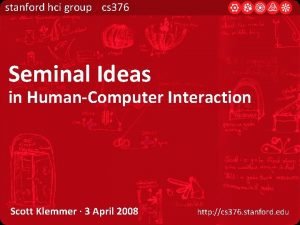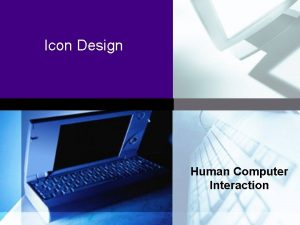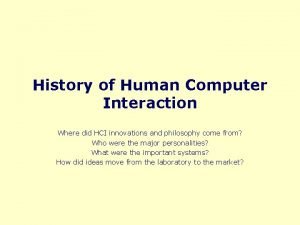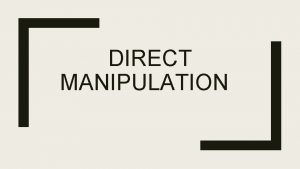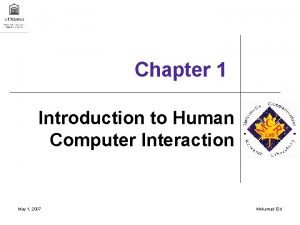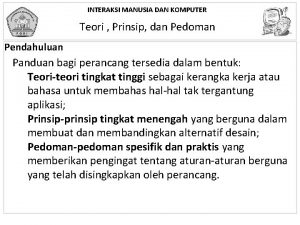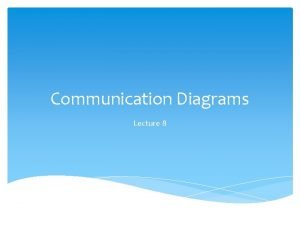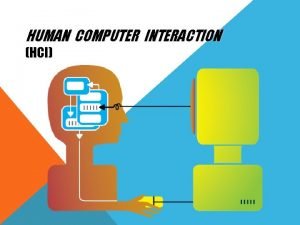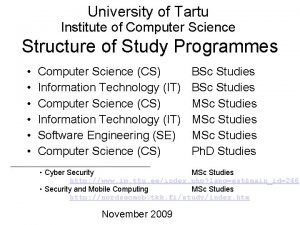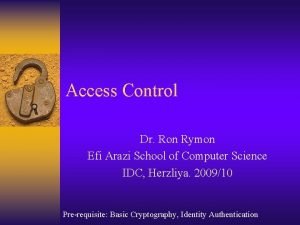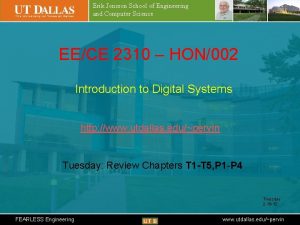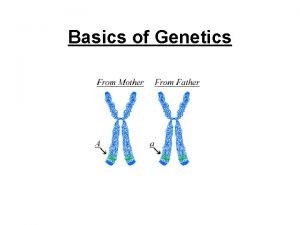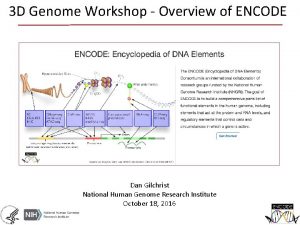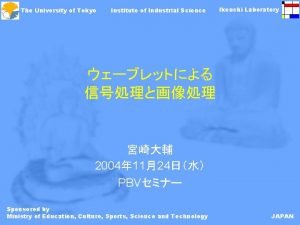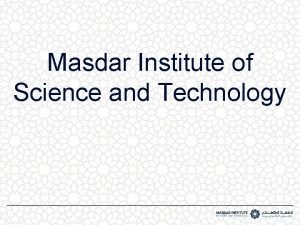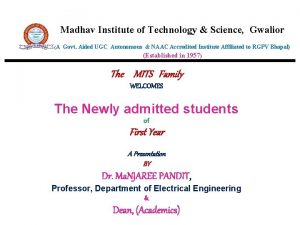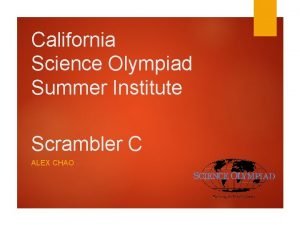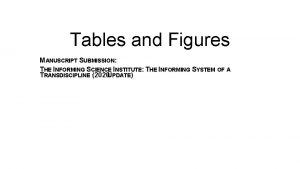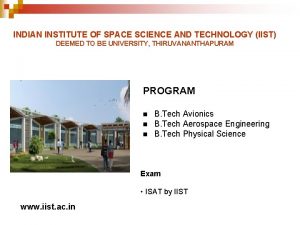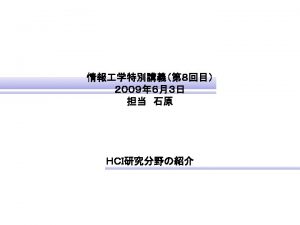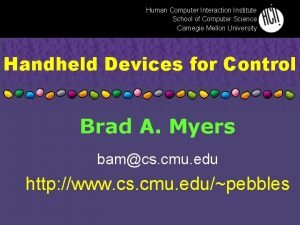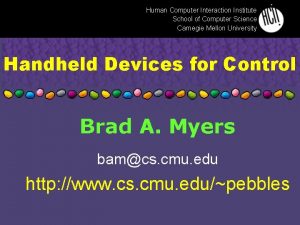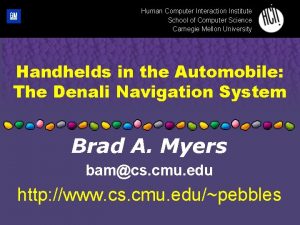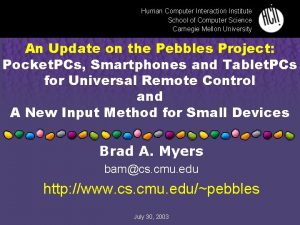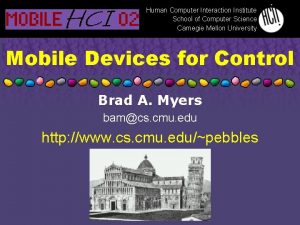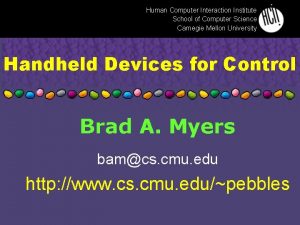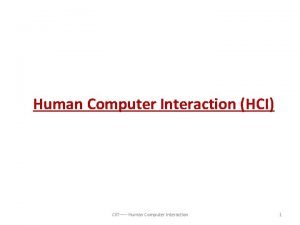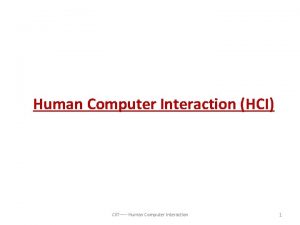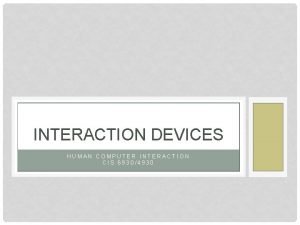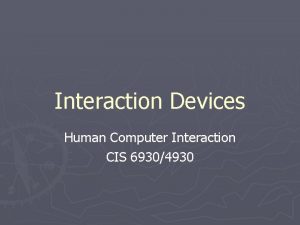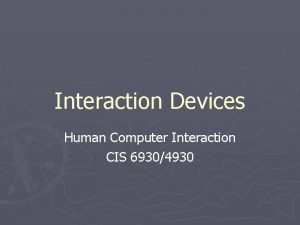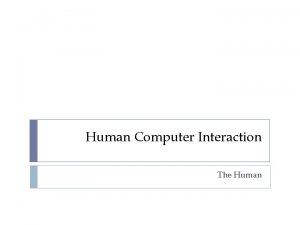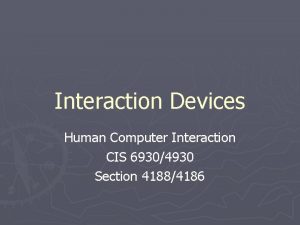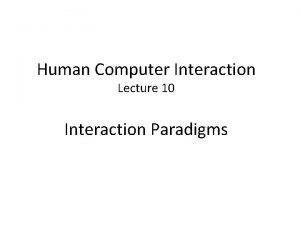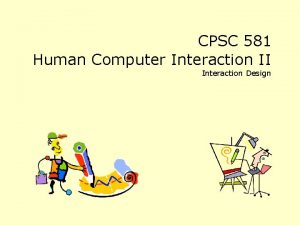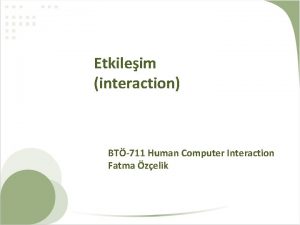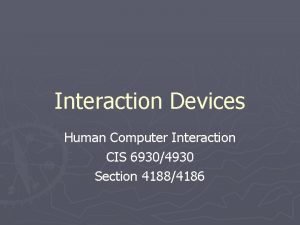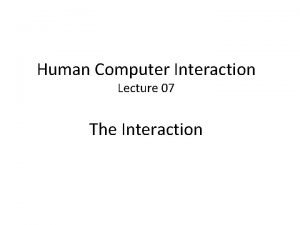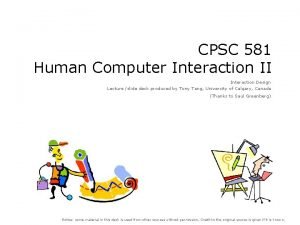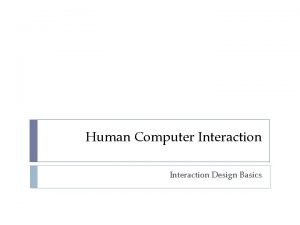Human Computer Interaction Institute School of Computer Science


















































- Slides: 50

Human Computer Interaction Institute School of Computer Science Carnegie Mellon University Handheld Devices for Control Brad A. Myers Jeffrey Nichols, Jacob O. Wobbrock, Kevin Litwack, Michael Higgins, Joe Hughes, Thomas K. Harris, Roni Rosenfeld, Mathilde Pignol bam@cs. cmu. edu http: //www. cs. cmu. edu/~pebbles

Handheld Devices l Handheld Devices for: l l Communication As a “Personal Information Manager” As a “Personal Digital Assistant” As a PC replacement l l “Pocket. PC” Mobile Devices for Remote Control of other devices l l Remote Control of PCs Remote Control of appliances Brad Myers Carnegie Mellon 2

Problem l Appliances are too complex Brad Myers Carnegie Mellon 3

Problem l Too many remotes Brad Myers Carnegie Mellon 4

Problem l April 8, 1991 Brad Myers Carnegie Mellon 5

Approach l Use a personal handheld device as an Interface to the PC and to the Appliances Brad Myers Carnegie Mellon 6

History of Communication l Parc. Tab – continuous communication l Early “organizers” – no communication l Newton – extra cost for synchronization l Palm – Hot. Sync once a day l Windows. CE/Pocket. PC – Active. Sync once a day Brad Myers Carnegie Mellon 7

Now, Handhelds will be Communicating l Toshiba e 740 802. 11 (“Wi-Fi”) HP i. Paq 3870 l Blue. Tooth l Cell-phone network (G 3) l (Infrared) l (Wires or cradle) Microsoft Smart. Phone Brad Myers Carnegie Mellon 8

Premises of our Research “With the coming wireless technologies, connecting the PCs and PDAs together will no longer be an occasional event for synchronization. Instead, the devices will frequently be in close, interactive communication. ” — Brad Myers, “Using Hand-Held Devices and PCs Together, ” Comm. ACM, Vol. 44, No. 11. Nov. , 2001. pp. 34 - 41. Carnegie Mellon 9

Pebbles Project l l Performed as part of the Pebbles Project Overall goal: Use of multiple devices at the same time l l l Palm and desktop PC Mobile Phone and “Smart Home” Multiple handhelds in a meeting Pocket PC and appliances Multiple users with their devices Single user with multiple devices Brad Myers Carnegie Mellon 10

Pebbles is: P DAs for E ntry of B oth B ytes and L ocations from E xternal S ources. http: //www. pebbles. hcii. edu/ Brad Myers Carnegie Mellon 11

Controlling a PC Remote Commander l Slide Show Commander l “Semantic Snarfing” l Shortcutter l http: //www. pebbles. hcii. edu/

Remote Commander l Allow PDAs to control a PC Can be used with any application l Uses the standard (single) cursor l Don’t have to jump up and grab mouse l All mouse and keyboard functions l Use PDA like touchpad l Graffiti or our own pop-up keyboard l l Word prediction and completion Brad Myers Carnegie Mellon 13

For People with Muscular Disabilities l Using handhelds as interface to PCs l People with Muscular Dystrophy have fine-motor control but lose gross motor control l l Difficulties with mouse and keyboard, but stylus OK So use Remote Commander as PC’s keyboard and mouse Brad Myers Carnegie Mellon 14

Pocket. PC version l l Get PC’s screen onto Pocket. PC Full view, or one-to-one zooming l l Scroll with i. Paq’s buttons Control or scribble Brad Myers Carnegie Mellon 15

Shared Clipboard l Transfer information among your personal devices l l l E. g. , between PDA and PC Also between multiple computers Connect all clipboards together Transfer content or reference Works with all applications Brad Myers Carnegie Mellon 16

Power Point Control l l Use PC to give the presentation Use hand-held to control the PC l l Two-way communication Hand-held shows picture of slide, notes, timer Brad Myers Carnegie Mellon 17

Slide. Show Commander, cont. l l l See list of slide titles Scribble Tap on on-screen buttons and links Preview other slides Control demonstrations Brad Myers Carnegie Mellon 18

Control at a Distance l Controlling a PC from across the room l l Use a laser pointer? l l Meetings, etc. Studies “Semantic Snarfing” l Grab contents to handheld Brad Myers Carnegie Mellon 19

Shortcutter l l User-created panels of controls Create custom interfaces and extensions to PC applications l l l And then take them with you Direct manipulation for edit, then set properties Pocket. PC or Palm Brad Myers Carnegie Mellon 20

Shortcutter Widgets l Buttons l Virtual Joy stick l Virtual Knob l Sliders l Mouse pad l Gesture panel Brad Myers Carnegie Mellon 21

Scenarios of Use l Lean-back mail reading l Controlling media players l … and many others Brad Myers Carnegie Mellon 22

Controlling Appliances l Ph. D research of Jeffrey Nichols http: //www. pebbles. hcii. edu/puc/

Problem l Too many complex devices, each with its own idiosyncratic interface l l l l Stereo system Telephones ATM Fax machine Photocopier Hotel alarm clock Increasingly computerized Low usability

Existing “universal” controls Pre-programmed at the factory with a subset, l Or, Laboriously hand-programmed by the user l Brad Myers Carnegie Mellon 25

Our Approach l l Handheld is a “Personal Universal Controller” (PUC) Two-way communication l l Appliance describes its functions Handheld PUC l Automatically creates interface l Controls the appliance l Displays feedback about appliance status Specifications Control Feedback Brad Myers Carnegie Mellon 26

Automatic Generation of UIs l Benefits l All interfaces consistent for a user With conventions of the handheld l Even from multiple manufacturers l l Addresses hotel alarm clock problem Can take into account user preferences l Multiple modalities (GUI + Speech UI) l l A Hard Problem l Previous automatic systems have not generated high quality interfaces Brad Myers Carnegie Mellon 27

Research Challenges 1. Automatic Design of Graphical User Interfaces 2. Automatic Design of Speech User Interfaces 3. Connection with real devices l l l Through various protocols X-10, AV/C, HAVi, UPn. P, etc. Also, custom hardware and software Brad Myers Carnegie Mellon 28

Hand-Generated Graphical Interfaces l First, Hand-Designed Pocket. PC interfaces: l l l AIWA Shelf Stereo (Tape, CD, Tuner) AT&T Telephone/Answering Machine Used Embedded Visual Basic Ensured quality with heuristic analysis and think-aloud studies Compared with manufacturer’s interfaces Brad Myers Carnegie Mellon 29

Results of Comparison l l Using PUC, users took 50% less time & made 50% fewer errors All differences are significant (p < 0. 05) Brad Myers Carnegie Mellon 30

Current PUC Specification Language l l XML Full documentation for the specification language and protocol: http: //www. pebbles. hcii. cmu. edu/puc/ l Contains sample specification for a stereo Brad Myers Carnegie Mellon 31

Properties of PUC Language l State variables & commands l Each can have multiple labels l l Typed variables l l l Useful when not enough room Base types: Boolean, string, enumerated, integers, fixed-point, floating-point, etc. Optional labels for values Hierarchical Structure l Groups Brad Myers Carnegie Mellon 32

Dependency Information l l Crucial for high-quality interfaces Expressed as <active-if> clauses l Operations: l l Combined Logically l l Equals, Less-Than, Greater-Than AND, OR Used for: l l l Dynamic graying out Layout Widget selection Brad Myers Carnegie Mellon 33

Specifications l Have working specifications for: l l l l Audiophase stereo X-10 lights control Sony Cam. Corder Windows Media Player Audio Re. Quest hardware MP 3 player Win. Amp Media Player Elevator Brad Myers Carnegie Mellon 34

Examples of Generated GUIs l Stereo and X-10 Brad Myers Carnegie Mellon 35

More Examples l Elevator Outside Brad Myers Inside Carnegie Mellon 36

Generating Speech Interfaces l “Universal Speech Interface” (USI) project l l l Creates grammar, language model and pronunciation dictionary from PUC specification l l Prof. Roni Rosenfeld of CMU http: //www. cs. cmu. edu/~usi Pronunciation from labels using phonetic rules Can provide other pronunciations as labels for fine-tuning Will use dependency information to help with disambiguation and explanation Supports queries and spoken feedback l Paraphrases as confirmation Brad Myers Carnegie Mellon 37

Adaptors l “Adaptors” provide the interface to existing (and future) appliances If do not support specification language directly Custom hardware l AV/C (standard protocol) l l l Custom software l l l Audiophase Stereo ARQ MP 3 player SIMA MP 3 player (future) l HAVi (current work) l l X-10 l l Light switches, etc. Brad Myers l Sony Cam. Corder Play. Station, etc. (future) Mitsubishi HDTV 65” TV Mitsubishi HDTV VCR UPn. P (future) l ? ? Carnegie Mellon 38

Adaptor for AV/C PUC Java Proxy Hand-written spec of AV/C devices PUC Java Library Our Java device code Multiple device controllers Automatic GUI generation Automatic Speech UI generation Our C++ code Microsoft Direct. Show library AV/C protocol Firewire cable (IEEE 1394) Brad Myers Digital Video Camera or VCR Carnegie Mellon 39

Demonstration l l l X-10 Camcorder through AV/C protocol for IEEE 1394 (Firewire) Two way communication: l When state changes from appliance, GUI is updated and can query state with speech Brad Myers Carnegie Mellon 40

Future Work on PUC l Controlling User “Experiences” l l Consistency for Users l l One command for multiple devices Play a DVD sets DVD, cable, TV Setting alarm clock sets heat, coffee, car And user preferences More devices l l General Motors automobiles Etc. Brad Myers Carnegie Mellon 41

For More Information l Many papers on the Pebbles web site l l On PUC and other work Most programs available for free downloading: http: //www. cs. cmu. edu/~pebbles l Slide. Show Commander was licensed for commercial sale http: //www. slideshowcommander. com Brad Myers Carnegie Mellon 42

Conclusions l l As more and more electronics are computerized and communicating, mobile devices can help control them Handheld devices can improve the user interfaces of everything else l Not just be another gadget to be learned Brad Myers Carnegie Mellon 43

Thanks to Pebbles Students l This research performed by a large number of students since 1997: Rishi Bhatnagar Ben Bostwick Franklin Chen Yu Shan Chuang Karen Cross Carl Evankovich Marc Khadpe Dave Kong Chun-Kwok Lee Brad Myers Joonhwan Lee Jennifer Li Leo Lie Jack Lin Kevin Litwack A. Chris Long Rob Miller Jeff Nichols Choon Hong Peck Mathilde Pignol Herbert Stiel Marsha Tjandra Adrienne Warmack Jake Wobbrock Jerry Yang Sunny Yang Brian Yeung Carnegie Mellon 44

Thanks to Our Sponsors! The Pebbles research project is supported by grants from: DARPA Microsoft NSF Pittsburgh Digital Greenhouse General Motors And equipment grants from: Hewlett Packard Lucent Technologies Mitsubishi Palm Computing Symbol Technologies Brad Myers IBM SMART Technologies Vivid. Logic Synergy Solutions Handango Carnegie Mellon 45

Human Computer Interaction Institute School of Computer Science Carnegie Mellon University Handheld Devices for Control Brad A. Myers Jeffrey Nichols, Jacob O. Wobbrock, Kevin Litwack, Michael Higgins, Joe Hughes, Thomas K. Harris, Roni Rosenfeld, Mathilde Pignol bam@cs. cmu. edu http: //www. cs. cmu. edu/~pebbles

Black, followed by OLD

Discussion of Comparison l Our hand designed interfaces succeeded for several reasons l l Good organization Each button has one function Good labels Only available functions are active l l Others, hidden on tabs or grayed out Better feedback and error messages Brad Myers Carnegie Mellon 48

PUC Architecture Brad Myers Carnegie Mellon 49

Adaptor using Custom Hardware for Stereo l l l Pretends to send IR codes Reads LED panel signals to decode state Created by Pittsburgh company: Maya Design Brad Myers Carnegie Mellon 50
 Stanford hci
Stanford hci What is icon in hci
What is icon in hci Paradigms for interaction in hci
Paradigms for interaction in hci The human inputs and outputs information through
The human inputs and outputs information through Interaction framework in hci
Interaction framework in hci Direct manipulation
Direct manipulation Human computer interaction chapter 1
Human computer interaction chapter 1 Evolusi antarmuka pada level pemrograman pada tahun
Evolusi antarmuka pada level pemrograman pada tahun Yang termasuk model antarmuka objek-aksi
Yang termasuk model antarmuka objek-aksi Human computer interaction syllabus
Human computer interaction syllabus Pengertian hci
Pengertian hci Human computer interaction dix
Human computer interaction dix Communication diagrams
Communication diagrams Ergonomics in human computer interaction
Ergonomics in human computer interaction Hci merupakan
Hci merupakan Institute of computer science university of tartu
Institute of computer science university of tartu What's your favourite subject at school
What's your favourite subject at school What is hei in geography
What is hei in geography Spatial interaction ap human geography
Spatial interaction ap human geography Human characteristics of portland oregon
Human characteristics of portland oregon Spatial interaction ap human geography
Spatial interaction ap human geography What is egypt relative location
What is egypt relative location What is human geography
What is human geography Geographic scale ap human geography
Geographic scale ap human geography Dispersal hypothesis definition ap human geography
Dispersal hypothesis definition ap human geography Spatial interaction ap human geography
Spatial interaction ap human geography Human environment interaction
Human environment interaction What is a functional region
What is a functional region Relocation diffusion def
Relocation diffusion def Rome human environment interaction
Rome human environment interaction Interaction meaning in science
Interaction meaning in science Ron rymon
Ron rymon Erik jonsson school of engineering and computer science
Erik jonsson school of engineering and computer science Erik jonsson school of engineering and computer science
Erik jonsson school of engineering and computer science Erik jonsson school of engineering
Erik jonsson school of engineering National human genome research institute
National human genome research institute National human genome research institute
National human genome research institute National human genome research institute
National human genome research institute National human genome research institute
National human genome research institute Duke human vaccine institute
Duke human vaccine institute Ram raj science institute
Ram raj science institute Spike unist internship
Spike unist internship Institute of industrial science the university of tokyo
Institute of industrial science the university of tokyo Masdar institute of science and technology
Masdar institute of science and technology Madhav institute of technology and science
Madhav institute of technology and science Scrambler science olympiad
Scrambler science olympiad Korea institute of sport science
Korea institute of sport science Schorarly
Schorarly Informing science institute
Informing science institute Science olympiad summer institute
Science olympiad summer institute Iist pune
Iist pune
